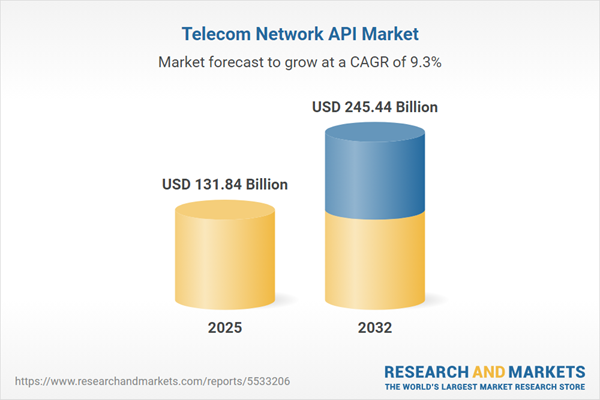Speak directly to the analyst to clarify any post sales queries you may have.
The telecom network API market is rapidly evolving, propelled by digital transformation and the integration of programmable network capabilities. Executive decision-makers must understand the shifting technology and regulatory landscape to unlock new business value, reduce operational risks, and realize the strategic opportunities within this sector.
Market Snapshot: Telecom Network API Market Size and Growth
The Telecom Network API market grew from USD 120.84 billion in 2024 to USD 131.84 billion in 2025. It is expected to continue growing at a CAGR of 9.26%, reaching USD 245.44 billion by 2032. This trajectory highlights a robust adoption of programmable interfaces, validated by widespread initiatives across network providers, enterprises, and technology vendors. The primary keyword telecom network API market is central to evolving business models, supported by increasing demands for secure, scalable, and flexible communications platforms.
Scope & Segmentation: Comprehensive Market Coverage
This report analyzes the entire value chain, mapping service adoption, technology integration, and deployment across global territories. The segmentation offers granular visibility into regional nuances and enterprise use cases:
- Service Types: Identity & Authentication APIs, Location APIs, Messaging APIs, Payment APIs, Voice APIs, WebRTC APIs
- Technologies: 2G, 3G, 4G, 5G
- Deployment Models: Private, Public
- Subscription Types: Postpaid, Prepaid
- End User Verticals: Consumer, Enterprise (Large Enterprise, Small Enterprise), Government
- Regional Coverage: Americas (North America: United States, Canada, Mexico; Latin America: Brazil, Argentina, Chile, Colombia, Peru), Europe, Middle East & Africa (Europe: United Kingdom, Germany, France, Russia, Italy, Spain, Netherlands, Sweden, Poland, Switzerland; Middle East: United Arab Emirates, Saudi Arabia, Qatar, Turkey, Israel; Africa: South Africa, Nigeria, Egypt, Kenya), Asia-Pacific (China, India, Japan, Australia, South Korea, Indonesia, Thailand, Malaysia, Singapore, Taiwan)
- Leading Companies: Twilio Inc., Sinch AB, Vonage Holdings Corp., Infobip Ltd, MessageBird B.V., Bandwidth Inc., Route Mobile Limited, Kaleyra S.p.A., TeleSign Corporation, Plivo Inc.
Key Takeaways for Senior Decision-Makers
- Adoption is driven by the need for dynamic, policy-driven interfaces that support real-time communication, authentication, and payment services across diversified network architectures.
- The secondary keyword network API adoption is accelerating in response to regulatory imperatives, such as data privacy and API security, requiring robust governance for compliance and risk reduction.
- Enterprises are leveraging open standards and programmable networks to achieve granular control, enhance monetization, and rapidly innovate with tailored service bundles for industry-specific needs.
- Regional strategies vary significantly; mature markets invest in private deployments for advanced automation, while emerging territories focus on scalable, prepaid API solutions to improve accessibility and inclusion.
- Developer experience and platform extensibility shape competitive differentiation, with ecosystem partnerships between operators, software firms, and cloud platforms facilitating broader integration and interoperability.
- Market leaders benefit from agility in subscription models and deployment, optimizing costs and driving sustainable expansion in both consumer and enterprise segments.
Tariff Impact: Navigating Shifts in Global Supply Chains
Recent United States tariffs have impacted API infrastructure by increasing costs for essential network components and specialized silicon. Operators and vendors are adapting procurement models, seeking diversified supply chains, and pursuing onshoring or collaborative agreements to balance price pressures with reliability and product innovation. This dynamic alters the competitive landscape, particularly affecting global supplier margins and future development investments.
Methodology & Data Sources
This analysis combines extensive secondary research—including technical documentation, regulatory sources, and industry briefings—with primary interviews involving network operators, cloud vendors, enterprise architects, and independent API specialists. All insights are rigorously triangulated, supported by quality assurance reviews and thematic analysis for accuracy and strategic relevance.
Why This Report Matters
- Enables stakeholders to benchmark technology investments, vendor strategies, and deployment choices against evolving market structures and security imperatives.
- Equips executives with objective, actionable guidance for navigating regulatory challenges, regional differentiation, and future-proof API monetization models.
- Supports operational resilience and growth planning by providing validated, segment-specific intelligence across service types, technologies, and end-user environments.
Conclusion
The telecom network API market offers significant potential for transforming digital communications, service innovation, and revenue generation. Senior leaders who align technology, compliance, and strategic partnerships will be positioned for long-term advantage.
Additional Product Information:
- Purchase of this report includes 1 year online access with quarterly updates.
- This report can be updated on request. Please contact our Customer Experience team using the Ask a Question widget on our website.
Table of Contents
3. Executive Summary
4. Market Overview
7. Cumulative Impact of Artificial Intelligence 2025
Companies Mentioned
The companies profiled in this Telecom Network API market report include:- Twilio Inc.
- Sinch AB
- Vonage Holdings Corp.
- Infobip Ltd
- MessageBird B.V.
- Bandwidth Inc.
- Route Mobile Limited
- Kaleyra S.p.A.
- TeleSign Corporation
- Plivo Inc.
Table Information
| Report Attribute | Details |
|---|---|
| No. of Pages | 186 |
| Published | October 2025 |
| Forecast Period | 2025 - 2032 |
| Estimated Market Value ( USD | $ 131.84 Billion |
| Forecasted Market Value ( USD | $ 245.44 Billion |
| Compound Annual Growth Rate | 9.2% |
| Regions Covered | Global |
| No. of Companies Mentioned | 11 |









